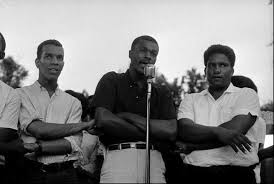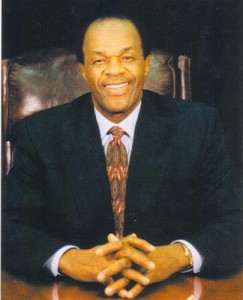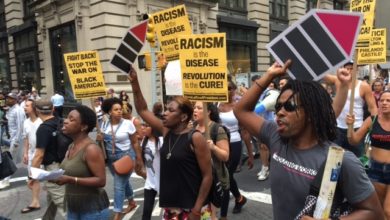

With the death of Marion Barry, it’s hard not to reflect on the passing of not only a man but an era. Mayor Barry was undoubtedly the most iconic of the post-Civil Rights Black politicians. He had a flair for strategy, tactics and presentation that was matched only by Adam Clayton Powell Jr. amongst Black politicians of any period.
Barry was, and still is, widely reviled and ridiculed for his personal struggles, but he gained the respect of millions because of his programs for the poor and his unabashed advocacy of Black rights. As the four-time mayor, 15-year District Council Member and president of the Board of Education, his ubiquitous presence earned him the moniker “Mayor for Life.”
His legacy is complicated, but beyond the finer points of policy, Barry personifies a phase of Black America’s struggle for liberation and the struggle against racism.
Origins
Marion Barry Jr. was born in the tiny city of Itta Bena, Miss., also the home of fellow SCLC activist James Bevel, to a family of sharecroppers during the depths of the Great Depression.
Barry was raised in Memphis, Tenn., and worked a variety of odd jobs as a young man, also becoming an Eagle Scout and ascending to LeMoyne College, a historically Black institution founded in 1862 to educate “free Negros.”
At LeMoyne, Barry became president of the campus NAACP and, after graduating, matriculated at Fisk University in Nashville, another “historically Black college and university,” for a master’s degree in chemistry, starting the NAACP chapter there as well. In February 1960, students at North Carolina A&T (yet another HBCU) electrified the nation with student sit-ins against racist segregation at lunch counters.
In Nashville, Black students streamed into the struggle picketing lunch counters and later movie theaters and other segregated establishments, led by the young minister James Lawson, a disciple of Gandhi and Martin Luther King, who trained the students in protest tactics and principles.
Lawson brought a large delegation of students to the conference that became the founding conference of the Student Non-violent Coordinating Committee that fall. After much debate, a chairman was chosen. The position went to Marion Barry. Civil Rights historian Taylor Branch dubbed him “the most politically skillful of Lawson’s delegation.”
In 1961, SNCC freedom fighters traveled to McComb, Miss. Sharecroppers in the surrounding counties like Amite were ready and urged an expansion into their counties. In these areas of Mississippi, it was so dangerous for a Black hand to cast a ballot, scarcely anyone could remember the last time a Black person had voted.
SNCC, however, was determined. Along with a dozen or so others, Marion Barry appeared in McComb ready to knock on doors, literally risking death every day in the fight for voting and human rights.
At the non-violence workshops, teenagers who were too young to vote filled many of the seats. They wanted to do something. Marion Barry told them to demonstrate at the library, which wouldn’t let dark skin past the door. The arrests that day led to the first mass meeting in McComb and further protests. It would become one of the most hotly contested areas of civil rights activity.
Barry comes to Washington, D.C.
Barry later made his way to Washington, D.C., in 1965, first to take over SNCC’s D.C. office. It’s worth remembering that Marion Barry was of a generation of the young and precocious who weren’t afraid to risk death to demonstrate that Black people in America really were free.
Barry quickly set his sights on the Southern villains and their local friends who ran the District.
After organizing a bus “mancott” against fare increases that started to build a political base, Barry organized the Free D.C. movement. Free D.C. took aim at the “D.C. Power Structure,” which essentially consisted of the moneyed interests of the city in which landlords/slumords were heavily represented. These interests worked in league with segregationists in Congress’s District Committee, led by South Carolina Representative John L. McMillian.
Rep. McMillian was more than happy to let everyone know how racist he was. When appointed mayor, Walter Washington sent Congress his first budget, McMillian sent back a truckload of watermelons.
Free D.C. focused on pushing for home rule in D.C., employing a variety of tactics. While people continue to debate Free D.C.’s impact on winning Home Rule, without a doubt it was the first mass manifestation of the sentiments of Black people in Washington, D.C., who were tired of living under the thumb of white politicians, businessman and their notoriously racist cops.
They wanted the right to vote and control their own destiny—and that movement was led by Marion Barry.
Barry was one of a number of leaders, including Dr. Calvin Rolark Jr. and Julius Hobson, who pressed a new type of uncompromising Black politics in cities across the country. Black politics had moved beyond seeking the benevolent support of white America. Instead they were moving towards a power politics concept that drew from the ethnic bloc politics of Irish and Italian urban political machines.
Black politics had awakened and was driving serious disruptions in U.S. society, which with no answer threatened to sweep away the calm stability of postwar capital accumulation.
As scholar Robert L. Allen explains in his “Black Awakening in Capitalist America,” this new “Black Power” emergence drew not just repression but also billions of dollars in funds designed to engage and co-opt sections of this powerful movement to stunt its growth.
Marion Barry sensed these changing winds and was able to turn the fear of some local elites and the federal government about uprisings in D.C. into funds to start Pride Inc. Pride Inc. ran a whole range of programs employing Black youth and creating jobs. It was Barry’s first springboard into office. In 1974, he ascended to the School Board, and from there D.C. Council.
In 1978, he was able to become mayor in a campaign that essentially cobbled together a small numbers of supporters around the District bucking the “establishment,” both Black and white, and which targeted city bureaucracy. Significantly, one base of support came from Washington’s gay community for whom Barry became the first politician to openly champion their rights.
Barry came to power at an auspicious time. Washington, D.C.—having experienced “white flight” after the 1968 riots, was witnessing a renaissance downtown. The proximity to capitalist politicians created a reason to want to work there, and the stability of government spending brought a flood of wealth, much of it from European pension funds, into the real-estate sector looking for a long-term return on investment.
Barry bootstrapped his own brand of Black capitalism to this boom. His administration required significant minority set-asides in many projects and created a role for Black lobbyists and lawyers. Barry also turned District government upside down, creating jobs for a new Black middle class. He also turned his attention to the downtrodden, starting summer jobs programs for young people, providing services to seniors and for the first time extending trash service to Ward 8.
In the grand scheme of things, outside of the downtown core, the D.C. economy remained in crisis. There weren’t enough jobs to go around. Big-time political donors and corporations had no intention of backing politicians advancing jobs programs.
As such, government programs could only partially alleviate poverty and many were poorly run.
Under Mayor Barry, the District’s underdeveloped services further deteriorated and the resources were not made available for the task. His political cronies often traded on their friendships with the mayor and the positions bestowed by him to enrich themselves rather than help the District’s citizens. This led to a series of corruption scandals throughout the 1980s that claimed the careers of a number of Barry’s aides.
As many activists of that time will attest, the Mayor Barry of those years often seemed more concerned with managing the rise of Black capitalists and negotiating with suburban and white power elites overseeing the economic renaissance, rather than with the needs of those at the bottom.
Despite this reality, no serious movement ever arose to challenge the mayor. This was principally because, despite his priorities, he continued to deliver tangible benefits to just about all parts of his political coalition, including the lowest sections of the working class. Barry remained an exceptionally skillful politician with a flair for the dramatic, which worked well with voters.
Barry’s “uber-cool” political style would see him riding around town in a chauffeured car and an entourage—more like a prizefighter than a politician. When the Washington football team won the Super Bowl in 1983, Barry flew back with the team and was the first one off the plane to be greeted by President Reagan.
The mayor also wasn’t afraid to hit the town. He was larger than life and the life of the party, running a city, dispensing favors, negotiating with the highest levels of government and business, and still able to stop in and have a drink and a dance with the average guy.
Mayor Barry’s use of substances, particularly cocaine, increased during this period, which led him into his most infamous moment. In the fall of 1990 while visiting with a woman who was not his wife, and who was an FBI informant, he was arrested on drug charges. Coached by the Feds to coax Barry into smoking crack in exchange for sex, the arrest was part of a broad case by the Justice Department designed to take down the high-flying Black mayor of the nation’s capital.
The jury mostly recognized the political frame-up and convicted him only on one minor charge of possession, leading to a six-month jail sentence.
Barry surged back in 1992 becoming Ward 8 Councilmember, then mayor again in 1994.
The District in the mid-1990s was mired in even worse poverty and deprivation, with nowhere near the resources to begin to address these problems. Barry presented a budget that required Congress to provide huge sums. Because Congress keeps the District in a colonial status, it denied D.C. the right to levy a commuter tax on affluent suburbanites who used District services free of charge. Nearly every other major city had such a tax as a major source of revenue. In addition, Congress deemed all untaxable federal property—worth billions—to be worth only a paltry yearly payment.
Congress instead took control of District government services, stripped Barry of almost all power and used racist narratives about “mismanagement” to deflect blame. In fact, the Control Board completely mismanaged the District, which achieved a new prosperity only on account of national economic trends, not Congressional paternalism.
After another brief bout outside political life, Barry returned to the D.C. Council for the last several years of his life representing Ward 8.
How will history judge Marion Barry?
How then to judge this most famous mayor of the District, and perhaps the country?
On the one hand, Barry was, like all political leaders, a prisoner to his historical circumstances. In the economic crisis of the 1970s, when Barry became mayor, capitalist power-brokers and their pawn politicians around the country had decided to let the Black poor and working neighborhoods hang out to dry. Black workers were “last hired, first fired” as the saying goes. Their labor and position among the reserve army of the unemployed both served to boost profit margins in corporate suites.
With no job-creation programs in action and social service funding sacrificed at the altar of “fiscal responsibility” and “culture of poverty,” no big city mayor ever had much of a chance to stem the spiral of poverty and violence that afflicted inner cities in the 1980s.
So whether or not the District could have been “run better,” the efforts of District agencies and workers would have been entirely inadequate. Only something much more drastic—upending the entire capitalist status quo on a national scale—could have had a significant impact.
Those who lay the “bad old days” at Barry’s feet are entirely ignorant of economic and political history. This narrative tying Barry’s personal life and the District’s “decline” is shot through with racism.
On the other hand, it was no great secret during that time that corporate powers were essentially destroying the Black community. Since the late 1960s, Black activists had been emphasizing that U.S. capitalism could never serve the poor and working class. These sorts of critiques were raised by many, some right in D.C. including, for example, Barry’s old SNCC colleague Kwame Ture (formerly known as Stokeley Carmichael).
Barry was one of the Civil Rights veterans who decided to embrace capitalism, warts and all, and get what they could from it—which turned out to not be very much for the Black community. So Barry was complicit, if not exactly responsible, in the ravages of his mayoral era.
Finally, one must emphasize that most of the opprobrium he faced was not because of what he did but what he looked like. The perception of his supposed misdeeds among many whites is so far beyond his actual deeds that “Marion Barry” became a proxy phrase for racist attitudes towards Black political leadership as whole, characterized as corrupt potentates presiding over crumbling metropolises.
These days, nearly every politician in D.C. is required to state how they don’t want to go back to “how it used to be”—which means when Marion Barry was the mayor. This occurs even though the current state, which is supposedly “good” from a capitalist perspective has resulted in record homelessness, a crisis in affordable housing, widespread poverty level wages and a studied callousness towards poor and working people from legislators. Barry’s political coalition and machine no longer possesses the same influence over government offices, but corporations have more power than was ever seen under Barry.
The contemporary political scandals and outrages deal primarily with things benefiting the new, more affluent, and mostly white residents of the District; they draw far less scrutiny or disapproval.
Ultimately, the naggings of Barry’s detractors can’t take away from the fact that they are small people in the annals of history, while he will loom large. Risking death to destroy Jim Crow alone raises him far above any of his critics.
A flawed, contradictory but still popular figure, Barry nevertheless defined a locality as almost no other single person has done. Marion Barry retained his popularity because he wasn’t afraid to fight for freedom or redemption.






